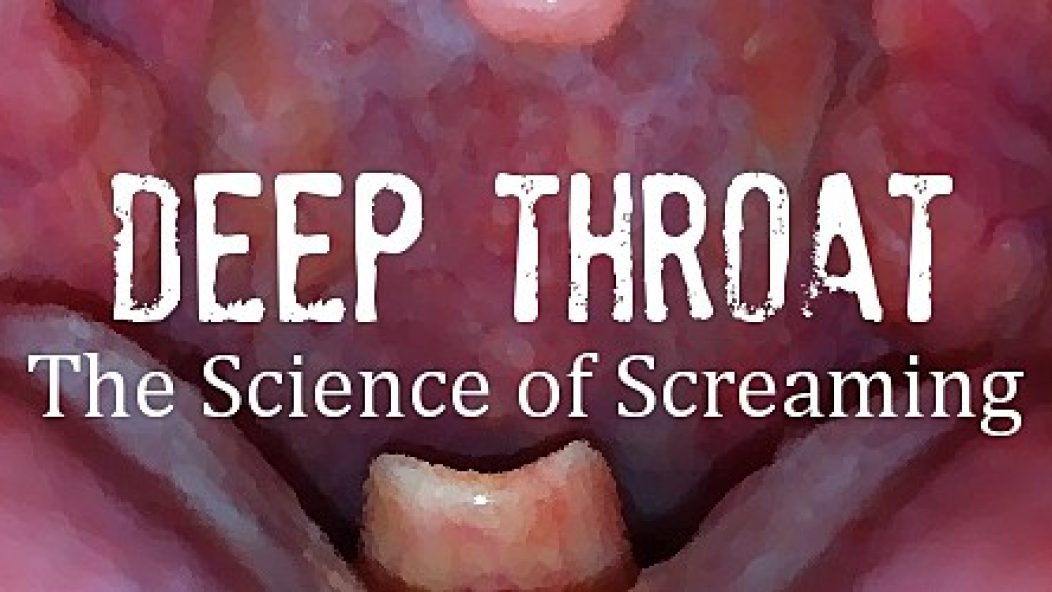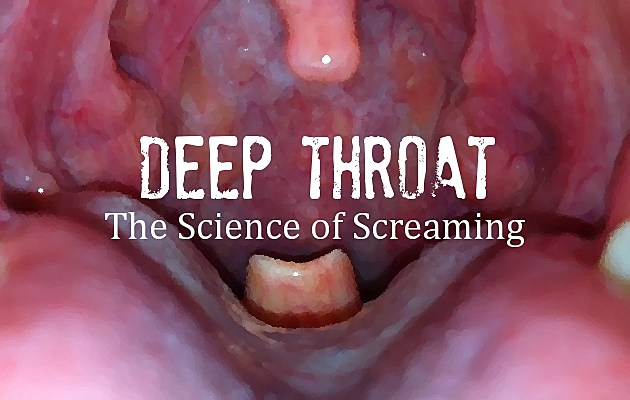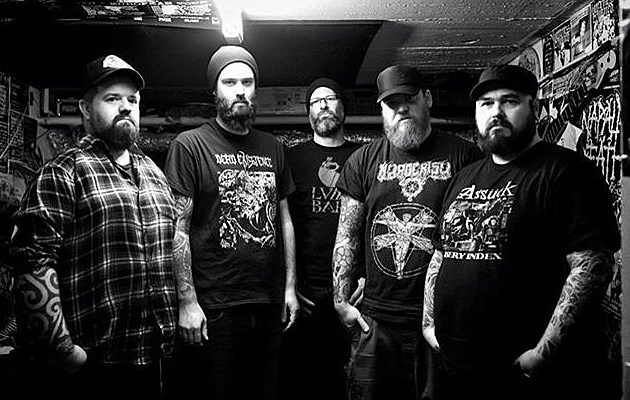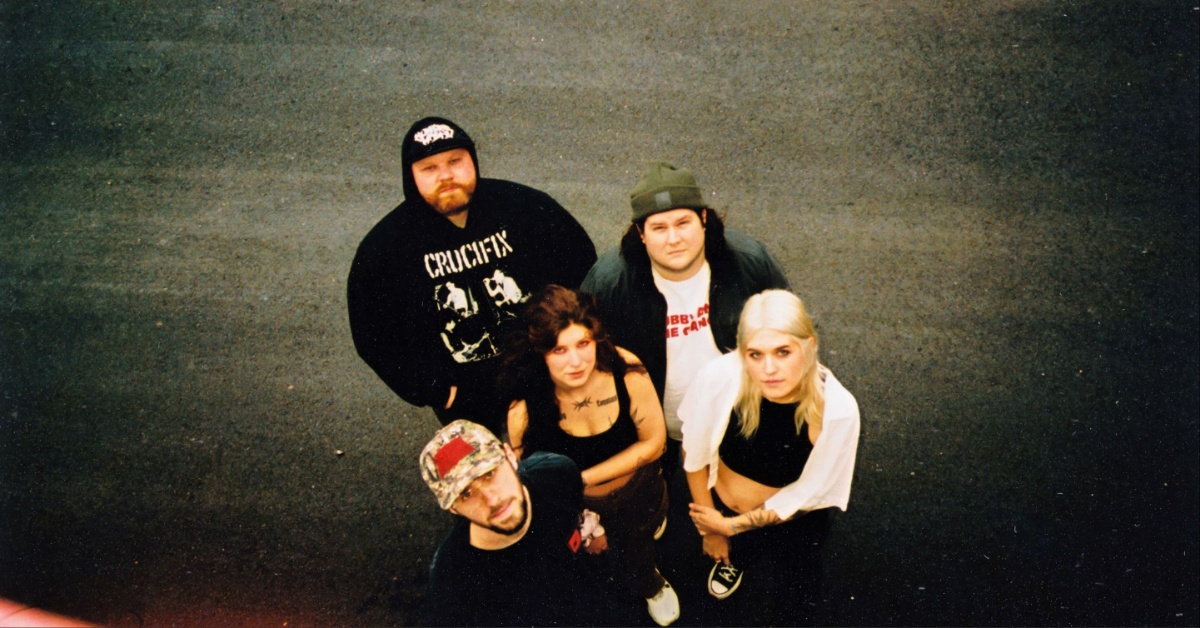
Deep Throat: The Science of Screaming

…
As a proud degree-holding science nerd, I am known to peruse scientific journals. A few months ago, I was reading the December 2012 edition of Science when a picture of the German band Bitterness Exhumed caught my eye. Needless to say, sweaty tattooed dudes yelling into a microphone aren’t part of a visual typically associated with this particular academic publication. How did it get there? Turns out a musicologist, Dr. Marcus Erbe of the University of Cologne, is exploring the heavy metal, death metal, and hardcore scene in Germany. He’s joined by linguist Dr. Sven Grawunder from The Max Planck Institute for Evolutionary Anthropology and Leipzig University School of Medicine’s Dr. Michael Fuchs, an ear, nose, and throat physician. Their goal? To find out exactly what happens when singers growl and scream.
To examine their screaming subjects, the researchers first use an endoscope. Indeed, the vocalists actually have a fiber-optic cable shoved down their throats to shoot video of the flapping of their vocal folds. Then, Dr. Grawunder compares the sounds to assorted languages and Tuvan throat singing. So far, the early results suggest aggressive use of the vocal chords may not be as harmful as people once believed, opening up potential therapies and training for vocalists who want to use their voices in extreme ways.
Unfortunately, the doctors’ research has stalled somewhat since the Science article, largely due to needing a physician present when utilizing the endoscope. However, though they’ve only conducted research on six people, they’ve been able to observe extreme vocalists from a perspective rarely seen — from the inside.
I was able to interview Dr. Erbe and Dr. Grawunder about their findings. Dr. Erbe and I exchanged emails, while Dr. Grawunder and I spoke on the phone. Luckily, they both speak and write much better English than I German.
…
First of all, can you please tell me your personal interest in heavy music? At what age did you get into heavy music? What is it that is appealing to you about this type of music?
Dr. Marcus Erbe: I fear my musical socialization in this field is fairly unremarkable. As both of my parents are musicians, they used to have a huge record collection. In the early years of my adolescence, I paid hardly any attention to their taste in music. Instead, I must have figured that it would be rebellious to get involved with a musical culture about which my parents have not had the faintest idea. So in the late 1980s, I started to dig hardcore rap. Hip hop acts such as Public Enemy, KRS-One, or Eric B. & Rakim became my musical idols and I took part in a number of MC battles.
Anyway, my hip hop fandom eventually let me take an interest in my parents’ vinyl, simply because I discovered among them many funk and jazz tunes that used to serve as sampling material for well-known hip hop tracks. Incidentally, I also discovered some guitar-driven albums by Deep Purple, Led Zeppelin, Jimi Hendrix, Funkadelic, etc. In hindsight, I would say that this was the moment when my enthusiasm for rap music started to fade and the seed for my ongoing appreciation of heavy music was planted.
The fact that I spent my late teens in North Rhine-Westphalia, which is the most populous state of Germany, certainly helped maintain contact with the performative side of this kind of music. Attending a show was the best. You had your Kreator and Sodom concerts right next door, and the very next day, another band like Pantera, Napalm Death, or Biohazard would play somewhere nearby. I remember that I especially liked going to gigs in smaller venues, when there was virtually no barrier between the artists and the audience.
Dr. Sven Grawunder: I’m now 42. I like this music. I enjoy it. Bitterness Exhumed is one of the good examples I really like. I’m not a fan of any particular band really, but I enjoy skipping through the samples that Marcus brings out. We have these discussions when he finds a good vocalization — like, “Oh yeah, here’s something interesting. Oh yeah, that works!” — and the music that Marcus plays, it’s also good in terms of musical arrangements. The way that the voice is used and the entire embedding of the voice in the music I can certainly enjoy.
…

…
Tell me a little about your professional background. You are a musicologist. At what point did you begin to think about studying what happens in the voices of singers of heavy music?
Erbe: Right after I graduated in musicology, I would never have guessed that my research would bring me back to metal culture in the long run. Already as an undergraduate student, I specialized in contemporary music, which is, of course, a completely different strand of music represented by composers like John Cage or Karlheinz Stockhausen, and not so much by musicians such as Chuck Schuldiner and Chris Barnes. However, in my teaching I always took the liberty of pulling away from my central area of investigation and trying out new things. It was through a series of seminars on different aspects of heavy music that I rediscovered my interest in metal.
I also realized that the status of extreme genres within popular music — be it death metal, hardcore punk, or grindcore — is actually not that different from the status of new music in relation to classical music. Take, for example, the fact that both extreme metal and avant-garde composition have introduced a great deal of noise into the musical fabric. They also redefined the ways in which conventional instruments, among them the human voice, can be treated to obtain new sounds — and they are both being frowned upon by the general public.
My personal interest in the singing styles of extreme vocalists is actually part of a larger project regarding unusual modes of voice production. I recently started working on a book dealing with the phenomenon of the ‘monstrous’ voice across different media. What I find remarkable is that although we are really surrounded by bizarre voices, they are sometimes readily embraced, but at other times met with rejection.
Mass audiences seem to have no problem with the growls and snarls of demonic characters in horror films and video games. Children love it when voice actors like Frank Oz or Frank Welker breathe life into cartoonish villains and monsters. When it comes to music, however, all deviations from conventional ways of vocalization tend to be unsettling for most people. This applies just as much to the avant-garde performances of Diamanda Galás as to the various vocal styles found in death metal, black metal, or grindcore. I am currently trying to figure out why.
Sven, as a linguist, what is the connection between your study of languages and music?
Grawunder: I was doing field work on the study of music and voice. I’m coming from a speech therapy background and got hooked into linguistic field work and anthropological fieldwork on endangered languages, and the languages that I was studying also had an element of a certain type of singing. I was brought into this project of studying music through my documentation of the endangered languages that I was studying.
I’m interested in the German music scene. You have found some bands to work with. Are these bands you are fans of? Please tell me a little about the German heavy music scene in general. Is it difficult or socially isolating to be a heavy music fan in Germany? I have never been to Europe so I have no insight into this.
Erbe: I am not sure if I can answer that, because even supposedly coherent cultures — heavy metal would make for an excellent example — show a tendency to split up into more than one scene. In this respect, Germany is certainly no different from, say, the USA or Canada. At least from my experience in the field I can say that, although bands from diverse genres play together at festivals and have an overall friendly relationship with each other, they do not stand for any nonsense when it comes to defending their musical identity.
For instance, try asking the members of a grindcore band whether they play a special kind of death metal and you will be cut down to size immediately. Watched from the sidelines, the music in both genres may sound much alike. However, grindcore musicians usually trace their lineage back to punk rock and are therefore ill-disposed towards guitar solos and all-too-complex song structures.
When engaged in field studies, it is not necessary to be a fan of something. People will also be forthcoming if you take them seriously and respect the idiosyncrasies of their culture.
What bands have you worked with?
Erbe: Given the diverse nature of heavy music, I tried to get in contact with singers from as many different genres as possible. To name but a few, I have worked with the vocalists of Bitterness Exhumed, a hardcore/sludge metal combo from Karlsruhe, and Trailer Park Sex from Hamburg. Trailer Park Sex play a mixture of metalcore and jazz/funk. Their singer is a trained jazz vocalist who has not a only a powerful screaming voice, but also a superb singing voice, which was unusual for me, since most of the vocalists I encountered are self-taught.
There were several bands from the Cologne area, for example Pripjat (thrash metal), My Own Children’s Drink (death/grind), Jade & Lotus (progressive metal) and Inkarna (melodic death metal). In Leipzig, I met with the singers of Disillusion and the brutal death metal band Endemicy. I also had the opportunity to interview Jonny Davy (Job for a Cowboy/Fleshwrought) and Frankie Palmeri (Emmure).

You used an endoscope to make videos of the growls and screams of the vocalists. What did you learn from those videos? Was this what you expected or not what you expected?
Erbe: Since I am no phoniatrician, I did not know exactly what to expect. Thankfully, I was supported by two excellent researchers, namely the ear, nose, and throat specialist Michael Fuchs of the Leipzig University School of Medicine and Sven Grawunder of the Max Planck Institute for Evolutionary Anthropology. When you examine the larynx of a traditional singer, you will observe a periodic oscillation of the vocal folds resulting in a, more or less, harmonic spectrum. Seeing as how extreme vocals are everything but harmonic, I personally assumed that we would get a different picture with the participants of our study. Indeed, we were able to observe that during screaming, growling, squealing, etc. our test subjects activated additional organic structures in the throat.
We also noticed that there seems to be more than one way to produce a certain sound. The famous death growl, for example, can be achieved either by flapping one’s epiglottis (which is the tissue that normally protects the windpipe during the ingestion of food) or through a controlled vibration of the aryepiglottic folds. It is actually a bit more complex than that, but I do not want to bore you with the details. Apart from our clinical study, I recorded many solo performances in order to be able to analyze the vocals outside the ensemble context. What struck me there was the flexibility with which singers move easily from one mode of vocal production to the next. This is not only a matter of phonation, i.e. the way you adjust your larynx, but to a great extent of articulation, that is to say how you shape your jaw, your lips, and your tongue. Hence, the vocals of extreme music are not as monotonous as many people may think, especially not when skilful singers such as Travis Ryan of Cattle Decapitation and the versatile Runhild Gammelsæter employ a wide range of unusual singing styles.
How does the ‘vibrating mucus’ that the endoscope picked up on the videos help protect the singer’s voices?
Erbe: Our team’s physician, Michael Fuchs, would be much more competent to answer the question. As far as I understand, the mucus in our throats generally prevents the delicate areas of the voice box from drying out. Since we measured very high velocities in the airstream during screaming, an insufficient amount of mucous fluid would probably lead to inflammatory reactions. However, if carried out correctly, one can assume that the vocal styles in question are no more susceptible to the development of voice disorders than traditional forms of singing. Aside from this medical issue, there is good reason to believe that the co-oscillation of mucus, of which we saw plenty, adds to the roughness of the sound.
As a linguist, what are you looking for in your work?
Grawunder: What we are actually looking for is specific patterns of movements of the organs or part of the organs that are involved in singing. What we really want to understand is how — for the different voice types that singers may use or even speakers may use — this organ is working. We cannot really easily observe our larynx, so how this organ is actually working is an unstudied field.
With the very extreme voices that we find in metal, or other types of singing and even other types of speech, there’s almost nothing available, and what is available shows us the use of this organ is highly variable. That’s because every human being develops these structures based on their own anatomical factors, so during childhood and early youth when the larynx was growing and being used, there are specific pathways to the development. At the end, if you look into different people’s throats, the same organ always looks different. It means you have to adapt to your own larynx on the one hand, and on the other we want to know what are the common things about the larynx that each person shares. This is something that had been ignored, let’s say, until the development of the endoscope maybe 10 or 15 years ago.
Tell me about the comparison between metal vocalizations and Tuvan throat singing.
Grawunder: They are dissimilar styles of vocalizations, so it’s what they use individually and what they both use. That is what we are looking for. There are particular forms of throat singing, especially the low growling types, that are presumably using the larynx in a similar way and that’s what we are hoping to observe.
We are discovering more and more functions of the larynx and this shows us that everything is connected. So this is new information just because of the problem of observation. 10, 15, 20 years ago, you would just have a rigid endoscope that you would put in the mouth and the doctor would say ‘say aah’ for 10 seconds and this was our picture of a voice. But how would this actually work during speech or during singing? So this is something that hasn’t been studied, especially how other voice types are connected. The Tuvan throat singing, like the metal vocals, is another extreme in the use of the human’s own larynx.
You mentioned in your initial email that your research has stalled a bit and that it got to be public before you felt you were ready. How is the research coming along?
Grawunder: The research stalled just because of a bottleneck in the whole process. You have to fit this into a clinical setting since we need an MD to watch the procedure and the specialist that we are working with is in demand.
We are actually still looking for singers to be investigated. We are observing huge variations between singers, so that’s our problem. In order to say something more general we need more observations and so far we have only had six observations and that’s barely nothing, so that’s why I was not too happy about it getting public so fast. But we have to deal with it now and we’re hoping that we can collect much more recordings and be able to say what is typical, what is seen most often, what most singers do.
And maybe this is one of the questions we can answer, to protect people who use their voices a lot in extreme ways. If there is an instance when someone says, “If I do this then it hurts me after a while or it starts to hurt quite soon,” then we can understand why that happens. So there are singers who are looking for assistance. They tell us, “I’m interested in what my voice is doing, is there a right way to do it?”
If you ask what would come out of such research as this, then that’s actually a big possible outcome. So actually, with this type of research, you would have a basis on what doctors could recommend to people who are singers or who use their voices in any extreme ways. So, the research suggests that people can use their voices in even more extreme ways than we were aware of before, but there are still limits.
…
To learn more about this type of research, Dr. Erbe would like to refer readers to the newly published collection Hardcore, Punk, and Other Junk: Aggressive Sounds in Contemporary Music, for which he has written a chapter on the subject.
…










